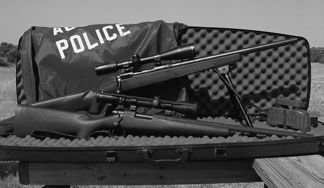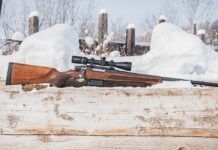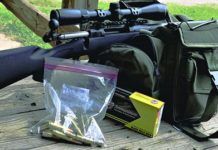
The 1960s were a trying time for law enforcement in America. Radical anti-government groups were popping up, and drug use began its long-term intrusion into everyday life. Shoot-outs with police were becoming more common. Criminals were starting to take more hostages during the commission of crimes. It became clear to law-enforcement leaders that they needed officers with specialized training for these situations. The days of using military surplus weapons, .38 revolvers and shotguns had changed.
Chief Daryl F. Gates of the Los Angeles Police department has been credited with starting the first SWAT (Special Weapons and Tactics) team in 1967. It was composed of sixty of the department’s best marksmen. Now most large departments have a well-trained SWAT Unit that is capable on being called into action 24 hours a day. To supplement SWAT and to secure crime scenes until SWAT can arrive, ERTs (Early Response Teams) have been developed in the ranks of the regular patrol officers. This is where there is a great need for less expensive and easily transported tactical rifles, such as those with 20-inch barrels.
Why a short-barreled rifle, you ask? In urban situations a short-barreled rifle is easier to handle in close quarters. Since the size of today’s police cars are shrinking, a short-barrel rifle is much easier to carry in the trunk or even in the front seat. Departments need trained officers with rifles capable of sub-MOA accuracy. For the civilian, these rifles are handy, easy to carry, fun to shoot, and make great hunting rifles.
We recently tested two guns that fit in this class: Remington’s Model 700 LTR (Light Tactical Rifle) .308 No. 5739, which usually sells for about $850, and the Savage 10FP .308, $621.
How We Tested
We knew one of the first things our readers would want to know is how the 20-inch barrel affects the rifles’. So to answer this question we tested a Remington 700 VS in .308 with a 26-inch barrel. The statistics have been included in our accuracy and chronograph table nearby, but briefly answer your question about loss of velocity compared to a 26-inch barrel: We saw a loss of as much as 276 fps to a velocity loss as low as 11 fps. As far as accuracy goes, our two test rifles had slightly better groups than the 26-inch barreled rifle.
To test these two rifles we decided to shoot five different brands of ammunition with both 150- and 168-grain bullets. We wanted to try regular hunting ammo, such as that you can find in any discount store, and we wanted to try the match ammunition most departments use. All accuracy testing was done off a bench at a private range in Lampasas County, Texas. To test the tactical capabilities we also shot the rifles using a Harris bipod. We shot five-shot strings with a good cleaning in between each string.
Our test ammos included Winchester Power Point 150-grain bullets, a widely available, affordable hunting round; Hornady Custom 150-grain BTSP rounds, that company’s every day .308 hunting ammunition; Federal Gold Medal Match .308 168-grain Sierra Matchking BTHPs (boattail hollowpoints), the king of the hill for .308 target shooters for years; and Winchester’s Supreme Match 168-grain BTHPs. To round off our test we chose the .308 TAP, manufactured by Hornady. The TAP ammunition is expressly designed for personal defense, and this .308 had a 168-grain A-max bullet.
To make things even we used the same scope on each rifle. It was the new model Bushnell 3200 7-21×40. This scope did an excellent job of helping the shooter get the best accuracy out of the rifles, as can be seen in the groups shot. It held up well to being moved and sighted in on three rifles. (Normally, tactical rifles are equipped with smaller scopes with less power, usually in the 4-14X range.)
Here’s what we thought of each rifle in more detail:
[PDFCAP(2)]
Remington does not have a suggested retail for this rifle. They let the dealers set the price, with $850 being an average selling price. Even though the rifles are produced in small volumes for the police and military, they are occasionally available to the public. This 20-inch model is available in .308, .223 and .300 SAUM. Remington also sells a .308 LTR TWS (Total Weapons System) that is scoped, cased, and comes with bipod and sling. In other words, it is ready to go.
The 700-series action’s bolt face, barrel, and receiver surround and support the cartridge head. The Model 700 receiver is machined from ordnance-grade steel, and the muzzle crown is recessed to protect the rifling. This is the same action used for the M-24 Sniper Weapon System built for the U.S. Army.
The Model 700 LTR’s 20-inch barrel is 1.5 pounds lighter than the standard 26-inch version, and the 20-inch gun weighs in at 9.0 pounds. Model 700’s chambered for .223 Remington and .308 have five-shot (4+1) capacities.
This rifle has a floorplate for easy unloading. This is a safe and quick way to unload the rifle in the field. With the push of a button, located in the trigger area, the floorplate pops open, dropping the rounds in the magazine in your hand.
When you pick this rifle up, one of the things you first notice is the fluted barrel. The 20-inch barrel has three 3/8-inch-wide flutes. All the metal parts are matte finished, which is appropriate for a tactical rifle. The rifle comes drilled and tapped for standard 700 scope bases. We used Weaver two-piece bases on both rifles. The stock on the LTR is made for Remington by HS Precision. It has aircraft quality aluminum bedding blocks, which stiffen and stabilize the stocks, and allow for accurate and consistent torquing of the action screws against metal sleeves in the blocks. Remington advised that the action screws have 43 in.-lbs. of torque from the factory, but the screws can be tightened down to 65 in.-lbs., and this may improve accuracy slightly.
Our rifle had a 3.25-pound trigger, but we were lucky because most rifles leaving the factory are set at 4.5 pounds. Unlike the Savage, this trigger is not readily adjustable by the shooter. Our trigger was smooth and crisp, nonetheless.
[PDFCAP(3)]
Savage rifles are known for being accurate at a fair price. The 10FP was no exception. The stiff action of the Savage, combined with the barrel-nut attachment system and an adjustable Accu-trigger, provide for very accurate rifle right out of the box.
When you first pick this rifle up, you notice the weight and the balance. A scoped 10FP will weigh in at more than 10 pounds, but this rifle is not designed to be carried in the field. The button-rifled barrel is attached to the action by the use of a barrel nut; this and the strength of a top-loading action makes for a very stiff, accurate rifle. Metal parts are matte finished and non-reflective. The synthetic stock has dual pillar bedding sleeves. It has a smooth finish with checkering molded into it on the wrist and forearm. The mold marks are evident on the bottom and the right side of the stock.
Savage has a winner with the Accu-trigger. Ours came out of the box set at 1.75 pounds, but it is fully adjustable by the owner.
The bolt is oversized with a round knob on the end. This may look a little strange, but it came in handy when we tried some speed shooting. The big bolt handle is easy to find and operate quickly, we thought.
The rifles come from Savage drilled and tapped for scope mounts. Also, Savage includes a group the rifle shot during test firing. At the factory, this particular rifle shot a 0.44-inch group. The 20-inch barreled 10FP is available in .308 and .223. You can get an optional stock made by HS Precision, Choate or McMillan. These rifles are readily available to the public.
Shooting these rifles was a lot of fun, but you should know that when you shorten the barrel of a rifle, it tends to increase recoil and muzzle blast. Off the bench the accuracy of these rifles was almost identical. The LTR shot a best group of 0.34 inch, while the 10FP was very close with a 0.38-inch group. These were not flukes because the two rifles consistently shot less than 0.50-inch groups. Even though they both preferred 168-grain bullets, they liked different brands at that weight. Strangely, the LTR had consistently lower velocities with the same ammunition.
Since these rifles were designed for law enforcement and military use, we decided to shoot them off a Harris bipod, as quickly as we could shoot three shots. This test proved interesting. The LTR action was definitely smoother, while the 10FP’s oversized bolt handle made it easier to work. Using the TAP ammo our groups averaged 1.50 inches, and our time for three shots was around six seconds. With a little practice the groups and speed should get better.
Gun Tests Recommends
Savage 10FP .308, $621. Buy It. Savage makes an accurate, dependable rifle for a great price. The Accu-trigger makes it a pleasure to shoot and helps keep the groups small. It is a well-thought-out rifle for its intended use. The dual-pillar stock bedding helps it maintain the overall stiffness of the rifle and action. So if you are on budget, you could not go wrong with this rifle.
Remington 700 LTR .308, $850. Our Pick. Even though the LTR is a little more expensive, we felt it was a better rifle for tactical use. The stock is well worth the extra money since it is reinforced, textured, and finished better. The action was very smooth and functioned flawlessly. It was more accurate than the Savage, but the difference was so slight it was not a consideration. The bottom drop of loaded ammunition is a major safety feature.
-Written and photographed by John Johnston, using evaluations from Gun Tests team testers.






























